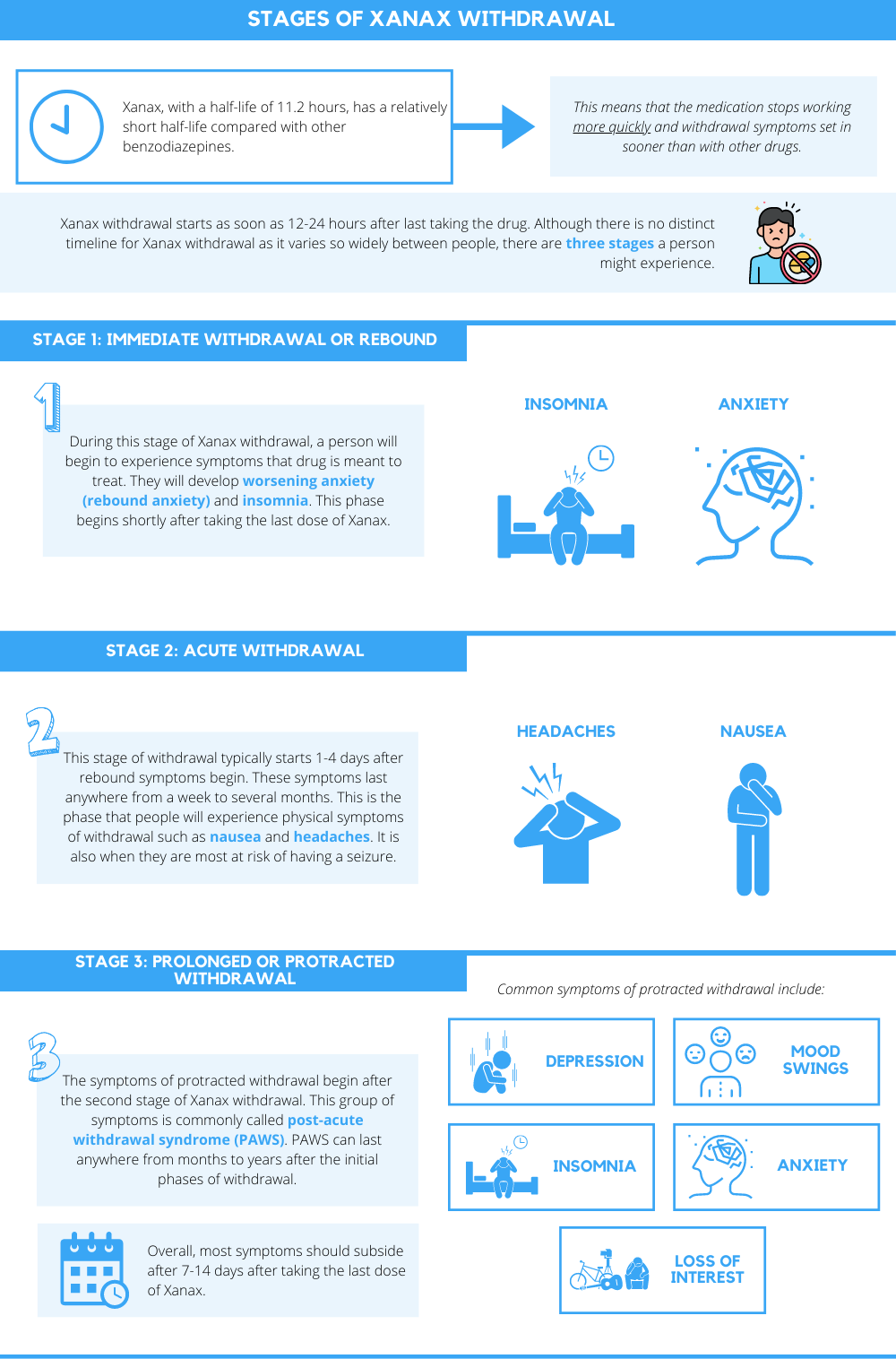Xanax is a medication commonly prescribed to treat panic and anxiety disorders. In the generic form, it is called alprazolam and is in a class of drugs known as benzodiazepines. Benzodiazepines, aka Benzos, act on the central nervous system (brain and nerves) to reduce anxiety and panic.
Although Xanax is successful at reducing anxiety, it is also a highly addictive substance.[1] As with any addictive drug, people who use Xanax at high doses or for long periods of time will experience withdrawal. The symptoms of benzodiazepine withdrawal are extremely uncomfortable, but knowing how long Xanax withdrawal lasts will help prepare you for what to expect.
Xanax Withdrawal Symptoms
Xanax addiction occurs when an individual takes the drug for extended periods of time and at high doses. It is possible to develop an addiction to Xanax even when taking it as prescribed by a doctor. Many people also take this medication recreationally or more often than recommended, which can also lead to Xanax addiction.
Xanax increases the activity of a neurotransmitter (GABA), which is known to produce calming, anxiety-reducing effects. As the brain is continually exposed to Xanax, it gets accustomed to having it in the body and requires higher doses of the drug to experience the benefits. This can cause a person taking Xanax to develop a tolerance to the medication. [2]
As the brain and body become dependent on Xanax, this increases the risk of developing withdrawal symptoms after stopping Xanax. Common withdrawal symptoms include:

- Insomnia
- Irritability
- Increased anxiety and panic attacks (rebound anxiety)
- Tremors
- Nausea
- Headaches
- Sweating
- Seizures
How long Xanax withdrawal lasts is dependent on how much a person is used to taking, how long they have been addicted, and other unique factors related to their metabolism and overall health.
Xanax Detox
Once a person stops taking the drug and starts to experience withdrawal symptoms, they will need to go through medical detox. During detox, the individual is usually monitored by healthcare professionals.
Most people detoxing from Xanax will be put on a taper, which means they will gradually be taken off of the drug to minimize unpleasant withdrawal symptoms. Tapering can increase the amount of time it takes to detox from Xanax.
Xanax detox is done as either outpatient or inpatient. Choosing whether or not to do inpatient or outpatient detox depends on the severity of the Xanax addiction, withdrawal symptoms, and the risk for complications from withdrawal symptoms. Individuals who have a higher risk of developing complications associated with withdrawal symptoms, such as seizures, are recommended to undergo inpatient detox.[3]
Stages of Xanax Withdrawal

Xanax, with a half-life of 11.2 hours, has a relatively short half-life compared with other benzodiazepines. This means that the medication stops working more quickly and withdrawal symptoms set in sooner than with other drugs.
Xanax withdrawal starts as soon as 12-24 hours after last taking the drug. Although there is no distinct timeline for Xanax withdrawal as it varies so widely between people, there are three stages a person might experience.[4]
Stage 1: Immediate Withdrawal or Rebound
During this stage of Xanax withdrawal, a person will begin to experience symptoms that drug is meant to treat. They will develop worsening anxiety (rebound anxiety) and insomnia. This phase begins shortly after taking the last dose of Xanax.
Stage 2: Acute Withdrawal
This stage of withdrawal typically starts 1-4 days after rebound symptoms begin. These symptoms last anywhere from a week to several months. This is the phase that people will experience physical symptoms of withdrawal such as nausea and headaches. It is also when they are most at risk of having a seizure.
During this stage, it is important to detox from Xanax with the aid of a medical professional. A Xanax taper might be prescribed to help lessen the severity of withdrawal symptoms. Additional medications will be prescribed to combat and treat withdrawal symptoms and reduce the risk of seizure.
Stage 3: Prolonged or Protracted Withdrawal
The symptoms of protracted withdrawal begin after the second stage of Xanax withdrawal. This group of symptoms is commonly called post-acute withdrawal syndrome (PAWS). PAWS can last anywhere from months to years after the initial phases of withdrawal.
Common symptoms of protracted withdrawal include:
- Depression
- Mood swings
- Insomnia
- Persistent anxiety
- Loss of interest or motivation
These symptoms, although less likely to cause physical discomfort, are capable of causing extreme mental duress. It is important to manage symptoms with ongoing therapy as well as medications, such as antidepressants.
Overall, most symptoms should subside after 7-14 days after taking the last dose of Xanax.
Seeking Help for Xanax Withdrawal
Rather than focusing on how long Xanax withdrawal lasts, it’s best to focus on obtaining the professional care and support you need to begin your recovery journey. It is important to reach out for help when stopping Xanax, as the symptoms of withdrawal are difficult and even dangerous to manage by yourself.
At Comprehensive Wellness Centers in sunny South Florida, we are here to help. Our staff of highly trained professionals will guide you through the detox process and make sure it is as safe and comfortable as possible. Call now to learn more.













